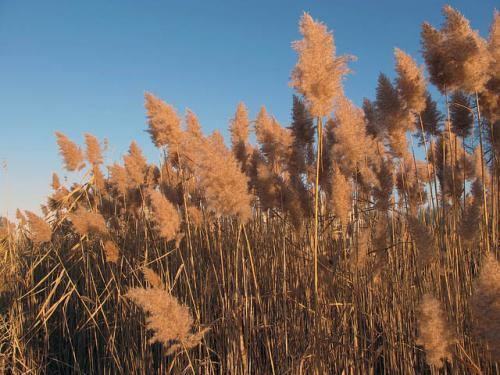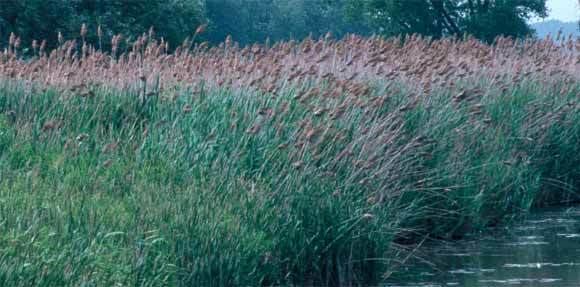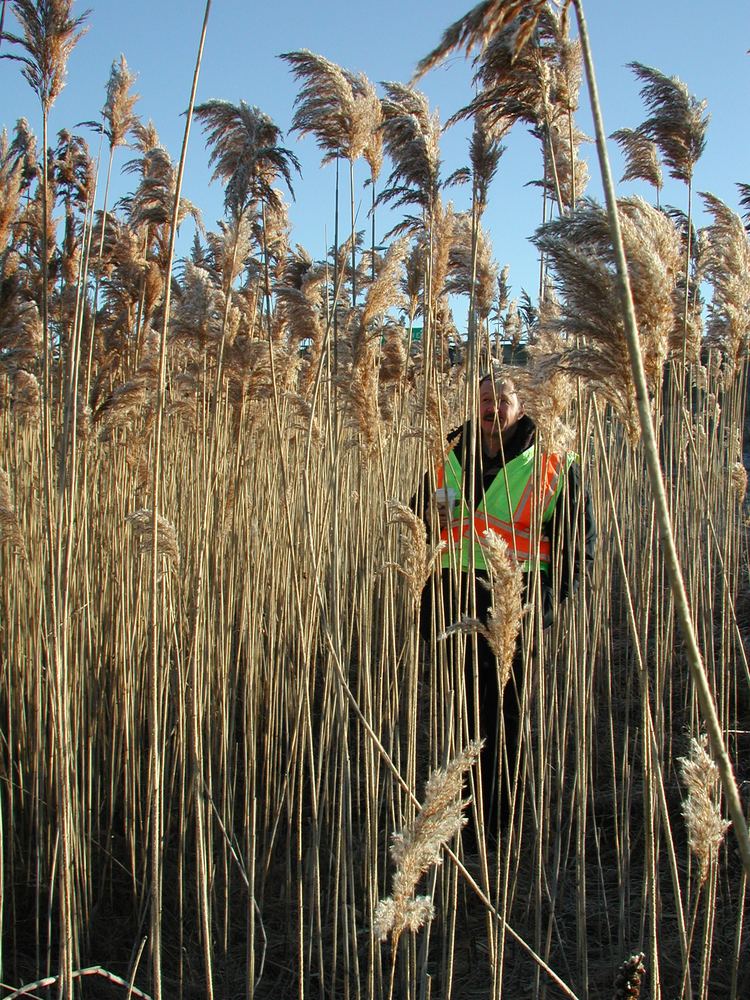Scientific name Phragmites Rank Genus | Higher classification Grasses | |
 | ||
Similar Knotweed, Japanese knotweed, Marsh Marigold, Ceratophyllum demersum, Garlic mustard | ||
Common reed phragmites australis
Phragmites is a genus of four species of large perennial grasses found in wetlands throughout temperate and tropical regions of the world. The World Checklist of Selected Plant Families, maintained by Kew Garden in London, accepts the following four species:
Contents
- Common reed phragmites australis
- Phragmites australis hd common reed 3d grass plant model tpf factory video growth animation youtube
- Taxonomy
- Subspecies and varieties
- Invasive status
- Growth and habitat
- Wildlife in reed beds
- Cultivation
- Phytoremediation water treatment
- Thatching
- Music
- Food
- Other uses
- Legend and literature
- References

- Phragmites australis (Cav.) Trin. ex Steud. – cosmopolitan
- Phragmites japonicus Steud. – Japan, Korea, Ryukyu Islands, Russian Far East
- Phragmites karka (Retz.) Trin. ex Steud. – tropical Africa, southern Asia, Australia, some Pacific Islands
- Phragmites mauritianus Kunth – central + southern Africa, Madagascar, Mauritius
Phragmites australis hd common reed 3d grass plant model tpf factory video growth animation youtube
Taxonomy

The cosmopolitan common reed has the generally accepted botanical name Phragmites australis. (Cav.) Trin. ex Steud. About 130 other synonyms have been proposed, and some have been widely used. Examples include Phragmites communis Trin., Arundo phragmites L., and Phragmites vulgaris (Lam.) Crép. (illegitimate name).
Subspecies and varieties
Recent studies have characterised morphological distinctions between the introduced and native stands of Phragmites australis in North America. The Eurasian phenotype can be distinguished from the North American phenotype by its shorter ligules of up to 0.9 millimetres (0.04 in) as opposed to over 1.0 millimetre (0.04 in), shorter glumes of under 3.2 millimetres (0.13 in) against over 3.2 millimetres (0.13 in) (although there is some overlap in this character), and in culm characteristics.

Invasive status

In North America, the status of Phragmites australis was a source of confusion and debate. It was commonly considered an exotic species and often invasive species, introduced from Europe. However, there is evidence of the existence of Phragmites as a native plant in North America long before European colonization of the continent. It is now known that the North American native forms of P. a. subsp. americanus are markedly less vigorous than European forms. The recent marked expansion of Phragmites in North America may be due to the more vigorous, but similar-looking European subsp. australis.
Phragmites outcompetes native vegetation and lowers the local plant biodiversity. Phragmites forms dense thickets of vegetation that is unsuitable habitat for native fauna. Phragmites displaces native plants species such as wild rice, cattails, and native wetland orchids. Phragmites has a high above ground biomass that blocks light to other plants allowing areas to turn into Phragmites monoculture very quickly. Decomposing Phragmites increases the rate of marsh accretion more rapidly than would occur with native marsh vegetation.
Phragmites australis subsp. australis is causing serious problems for many other North American hydrophyte wetland plants, including the native Phragmites australis subsp. americanus. Gallic acid released by Phragmites is degraded by ultraviolet light to produce mesoxalic acid, effectively hitting susceptible plants and seedlings with two harmful toxins. Phragmites are so difficult to control that one of the most effective methods of eradicating the plant is to burn it over 2-3 seasons. The roots grow so deep and strong that one burn is not enough. Ongoing research suggests that goats could be effectively used to control the species.
Growth and habitat
Phragmites australis, common reed, commonly forms extensive stands (known as reed beds), which may be as much as 1 square kilometre (0.39 sq mi) or more in extent. Where conditions are suitable it can also spread at 5 metres (16 ft) or more per year by horizontal runners, which put down roots at regular intervals. It can grow in damp ground, in standing water up to 1 metre (3 ft 3 in) or so deep, or even as a floating mat. The erect stems grow to 2–6 metres (6 ft 7 in–19 ft 8 in) tall, with the tallest plants growing in areas with hot summers and fertile growing conditions.
The leaves are long for a grass, 20–50 centimetres (7.9–19.7 in) and 2–3 centimetres (0.79–1.18 in) broad. The flowers are produced in late summer in a dense, dark purple panicle, about 20–50 cm long. Later the numerous long, narrow, sharp pointed spikelets appear greyer due to the growth of long, silky hairs.
It is a helophyte, especially common in alkaline habitats, and it also tolerates brackish water, and so is often found at the upper edges of estuaries and on other wetlands (such as grazing marsh) which are occasionally inundated by the sea. Phragmites australis has similar greenhouse gas emissions to native Spartina alterniflora.
Common reed is suppressed where it is grazed regularly by livestock. Under these conditions it either grows as small shoots within the grassland sward, or it disappears altogether.
In Europe, common reed is rarely invasive, except in damp grasslands where traditional grazing has been abandoned.
Wildlife in reed beds
Common reed is very important (together with other reed-like plants) for wildlife and conservation, particularly in Europe and Asia, where several species of birds are strongly tied to large Phragmites stands. These include:
In Australia, reedbeds provide cover for grassbirds (Megalurus spp), reed warblers (Acrocephalus spp), crakes (Porzana spp) and bitterns (Ixobrychus spp) and the Australian bittern (Botaurus poiciloptilus).
Cultivation
P. australis is cultivated as an ornamental plant in aquatic and marginal settings such as pond- and lakesides. Its aggressive colonisation means it must be sited with care.
Phytoremediation water treatment
Phragmites australis is one of the main wetland plant species used for phytoremediation water treatment.
Waste water from lavatories and greywater from kitchens is routed to an underground septic tank-like compartment where the solid waste is allowed to settle out. The water then trickles through a constructed wetland or artificial reed bed, where bioremediation bacterial action on the surface of roots and leaf litter removes some of the nutrients in biotransformation. The water is then suitable for irrigation, groundwater recharge, or release to natural watercourses.
Thatching
Reed is used in many areas for thatching roofs. In the British Isles, common reed used for this purpose is known as Norfolk reed or water reed. However "wheat reed" and "Devon reed", also used for thatching, are not in fact reed, but long-stemmed wheat straw.
Music
In Middle East countries Phragmites is used to create a small instrument similar to the clarinet called a sipsi, with either a single, as in the picture, or double pipes as in bagpipes. The reed of the zurna is made from the common reed which is flattened after removing its brittle outer glaze and the loose inner membrane, and after softening it by wetting. The result is a double reed with an elliptical opening that vibrates by closing and opening at a high speed. This is not to be confused with other double reeds like that of the oboe which uses two reeds made from the giant reed leaning against each other.
Food
Numerous parts of Phragmites can be prepared for consumption. For example, the young stems "while still green and fleshy, can be dried and pounded into a fine powder, which when moistened is roasted [sic] like marshmallows." Also, the wheat-like seeds on the apex of the stems "can be ground into flour or made into gruel." Rootstocks are used similarly.
Other uses
Some other uses for Phragmites australis and other reeds in various cultures include baskets, mats, pen tips, and a rough form of paper. Additionally, the reeds are used as nesting tubes by individuals keeping solitary bees such as mason bees.
In Egypt, the longer stems are dried and used as fishing poles. It is also used there for fences and cattle pens.
In the Philippines, Phragmites is known by the local name "tambo". Reed stands flower in December, and the blooms are harvested and bundled into brooms called "walis". Hence the common name of household brooms is "walis tambo".
Reeds have been used to make arrows and weapons such as spears for hunting game.
In Romania it is used to produce paper.
Legend and literature
When Midas had his ears transformed into donkey's ears, he concealed the fact and his barber was sworn to secrecy. However the barber could not contain himself and rather than confiding in another human, he spoke the secret into a hole in the ground. The reeds that grew in that place then repeated the secret in whispers.
Moses was "drawn out of the water where his mother had placed him in a reed basket to save him from the death that had been decreed by the Pharaoh against the firstborn of all of the children of Israel in Egypt" (Exodus 2:10). However, the plant concerned may have been another reed-like plant, such as papyrus, which is still used for making boats.
One reference to reeds in European literature is Frenchman Blaise Pascal's saying that Man is but a 'thinking reed' — roseau pensant. In Jean de La Fontaine's famous fable The Oak and the Reed — Le chêne et le roseau, the reed tells the proud oak: "I bend, and break not" —"Je plie, et ne romps pas", "before the tree's fall."
